Elasticity of Demand Class 12 notes Maharashtra Board (HSC) | Easy notes
Elasticity of Demand class 12 notes of Maharashtra Board (HSC) with practice paper
Q.2 Distinguish between : [4 Marks]
- Relatively elastic demand and Relatively inelastic demand.
- Perfectly elastic demand and Perfectly inelastic demand.
Q.3 Answer the following ( Any two) [8 Marks]
- Explain the factors influencing the elasticity of demand.
- Explain the importance of elasticity of demand.
- What is elasticity of demand? explain the types of elasticity of demand.
Q.4 Study the following table, and passage and answer the questions given below it (any two)


Q5 Answer the following questions in detail (Any two) [16 Marks]
- What is price elasticity of demand? explain different types of price elasticity of demand
- Explain the ratio method and point method of measuring the elasticity of demand.
- Explain the total outlay method of measuring the elasticity of demand.
What is Elasticity of Demand?
- The term elasticity indicates the responsiveness of one variable to a change in the other variable. It helps us understand how sensitive consumers are to price changes.
- The elasticity of demand is a “measurement of the relative change in quantity demanded in response to the relative change in price or any other factors”
- According to Prof. Marshall, “Elasticity of demand is great or small according to the amount demanded which rises much or little for a given fall in price and quantity demanded falls much or little for a given rise in price.”
- It is the ratio of the percentage change in quantity demanded of a commodity to a percentage change in price.
Relatively elastic demand and Relatively inelastic demand.
Relatively elastic demand |
Relatively inelastic demand. |
| When a change in price brings about more than a proportionate change in quantity demanded of a commodity. | When a change in price brings about less than a proportionate change in quantity demanded of a commodity. |
| It represents a flatter demand curve. | It represents a steeper demand curve. |
| For example- 20% fall in price leads to 80% rise in quantity demanded. | For example- 60% fall in price leads to 20% rise in quantity demanded. |
| Symbolically, Ed > 1 | Symbolically, Ed < 1 |
Perfectly elastic demand and Perfectly inelastic demand.
Perfectly elastic demand |
Perfectly inelastic demand |
| When a slight or zero change in the price brings about an infinite change in the quantity demanded of that commodity, it is called perfectly elastic demand. | When a percentage change in price has no effect on the quantity demanded of a commodity it is called perfectly inelastic demand. |
| The perfectly elastic demand curve is parallel to the OX axis | The perfectly elastic demand curve is parallel to the OY axis. |
| Symbolically, Ed = ∞ | Symbolically, Ed = 0 |
| For example- 10% fall in price may lead to an infinite rise in demand. | For example- 20% fall in price will have no effect on the quantity demanded. |
Factors influencing the elasticity of demand :
- Nature of the commodity: The demand for necessities like food grains, medicines, textbooks, etc. is relatively inelastic demand and the demand for luxuries and comfort like cars, perfumes, furniture, etc. is relatively elastic demand..
- Availability of substitutes: If the commodity has close substitutes, demand will be more elastic. For example, lemon juice, sugarcane juice, etc. But for commodities having no close substitutes like salt, the demand will be inelastic.
- Number of uses: Single-use goods have a less elastic demand. For example, Party Balloons, Disposable Plates and Cutlery, and Tissues. Multi-use goods have more elastic demand, For example, coal, electricity, etc.
- Habits: Habits make demand for certain goods relatively inelastic. For example, Toothpaste, Mobile Phone Data Plan, Milk, Laundry Detergent, etc.
- Durability: The demand for durable goods is relatively elastic. For example, furniture, washing machines, etc. The demand for perishable goods is inelastic. For example, milk, vegetables, etc.
- Complementary commodities: The elasticity of demand for a product can be influenced by its connection to other goods to satisfy a single want is relatively inelastic. For example, a fall in the price of mobile handsets may lead to a rise in the demand for SIM cards.
- Income of the consumer: Demand for Normal goods is usually inelastic if the consumer has a high income because they have enough money to buy the product even if the price changes a little. A very poor person’s demand may not change even if the price of necessary items like basic food increases because they may not have other options and would still buy those items.
- Urgency: Goods that are urgently needed will have relatively inelastic demand, for example, medicines. Luxury goods that are less urgent have relatively elastic demand.
- Time period: Elasticity of demand is always related to a period of time. It varies with the length of the time period. Generally speaking, the longer the duration of the period greater will be the elasticity of demand and vice-versa. This is because a consumer can change the consumption habits in the long run in favour of cheaper substitutes of the commodities.
Importance of Elasticity of Demand :
- Importance to the producer: – Every producer must determine the selling price for the product at which he has to sell it. For this purpose, the elasticity of demand becomes important. If the demand for a product is relatively inelastic, he will fix up a higher price and vice-versa. It is also useful for a monopolist to practice price discrimination.
- Importance to the Government: – Elasticity of demand helps the government in determining taxation policy. If the demand is inelastic the governments impose a higher tax and if the demand is elastic the governments impose less tax.
- Importance to factor pricing: – Elasticity of demand is very useful for determining the factor price. Factor, which has an elastic demand, is paid less wages. On the other hand, labour that has inelastic demand is paid higher wages.
- Importance in Foreign Trade: – Elasticity of demand is useful to determine terms and conditions in foreign trade. If countries exporting commodities demand is relatively inelastic can fix higher prices to earn more foreign exchange. For example, Organization of Petroleum Exporting Countries (OPEC) have increased the price of oil several times. It is also useful in formulating the export and import policy of a country.
- Public Utilities: In the case of public utilities like railways which have inelastic demand, Government can either subsidise (reduce the cost of a product or service) or nationalise (control by government) them to avoid consumer exploitation.
- Proportion of expenditure: When a consumer spends a very small portion of his income on a commodity demand will be inelastic and vice versa e.g. newspaper.
Types of elasticity of demand
- Income Elasticity of Demand.
- Cross Elasticity of Demand.
- Price Elasticity of Demand.
Income Elasticity: When percentage change in quantity demand of a commodity due to the change in the consumers income only, other factors including price remain constant, It is called as income elasticity demand. It can be expressed as follows:
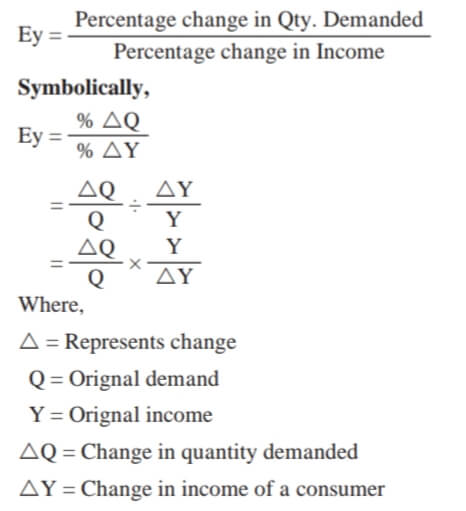
Cross Elasticity: Cross Elasticity of demand refers to a change in quantity demanded for a commodity due to the change in the price of complementary goods. For example Cars and Petrol, SIM cards and Mobile phones, etc.

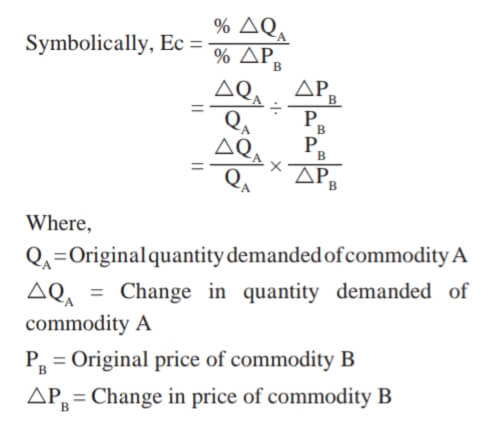
Price Elasticity: Price Elasticity of demand refers to percentage change in quantity demanded for a commodity due to percentage change in its price only, other factors remain the same.
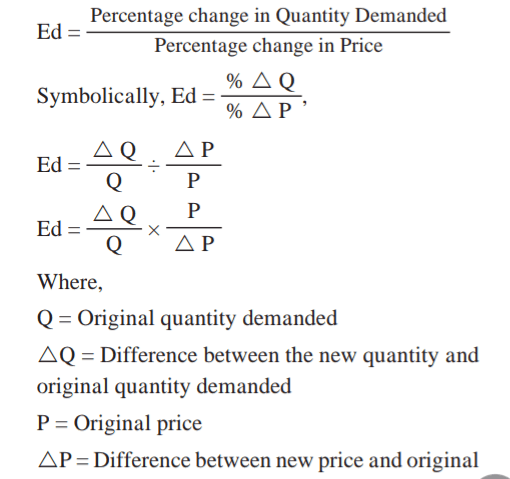
Types of Price Elasticity of Demand :
1. Perfectly Elastic Demand:
When a slight or zero change in the price brings about an infinite change in the quantity demanded of that commodity, it is called perfectly elastic demand. if the price changes by 1% may lead to an infinite rise in demand.
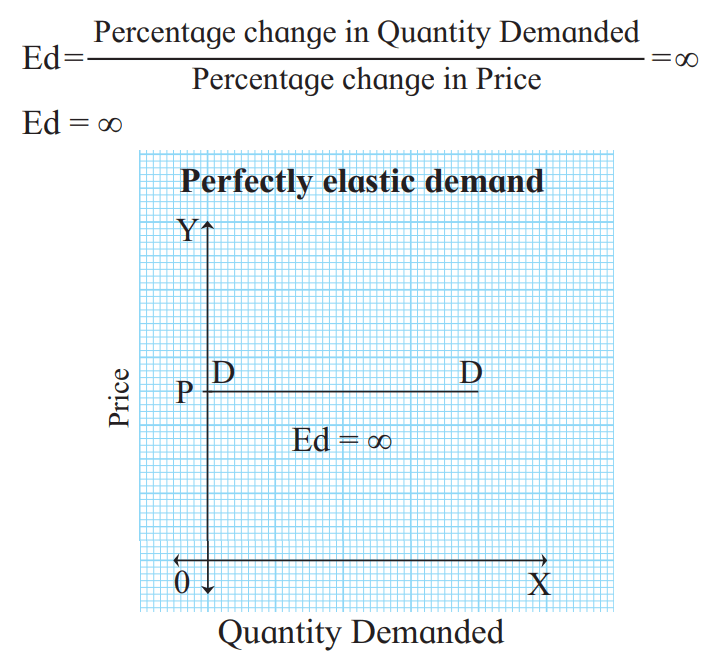
In the above diagram the demand curve DD is a horizontal line parallel to the X axis indicating perfectly elastic demand.
2. Perfectly Inelastic Demand:
When a percentage change in price has no effect on the quantity demanded of a commodity it is called perfectly inelastic demand. For example, 20% fall in price will have no effect on quantity demanded, demand for salt, milk etc.
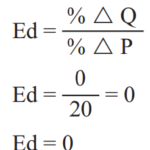
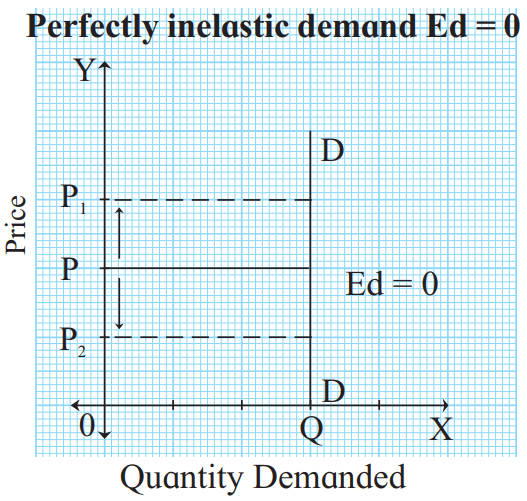
In the above diagram, when price rises from OP to OP1 or when price falls from OP to OP2 , demand remains unchanged at OQ. Therefore, the demand curve is a vertical straight line parallel to the Y axis, indicating perfectly inelastic demand.
3. Unitary elastic demand:
When a percentage change in price leads to an equal percentage change in quantity demanded, it is called unitary elastic demand. For example, 50% fall in the price of a commodity leads to 50% rise in the quantity demanded.
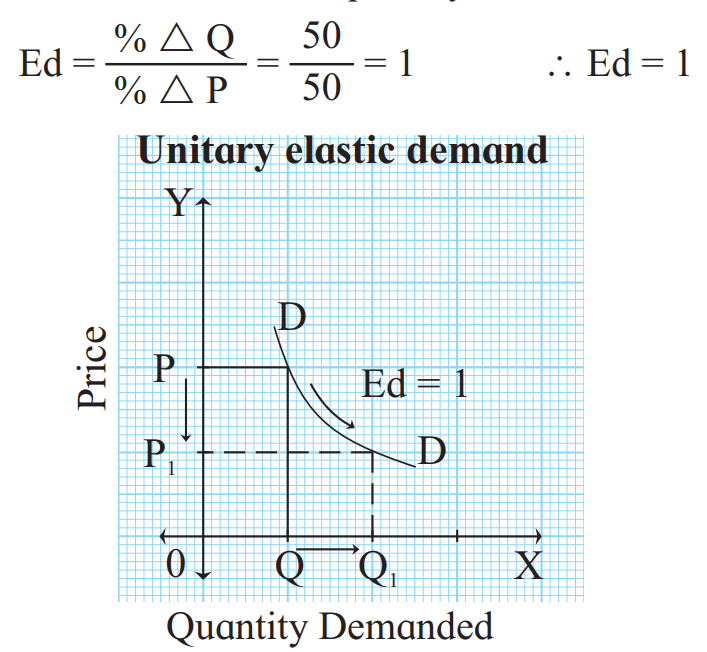
In the above diagram when the price falls from OP to OP1 (50%), demand rises from OQ to OQ1 (50%). Therefore, the slope of the demand curve is a ‘rectangular hyperbola‘.
4. Relatively elastic demand:
When a change in price brings about more than a proportionate change in quantity demanded of a commodity, it is called as relatively elastic demand. For example- 50% fall in price leads to 100% rise in quantity demanded.
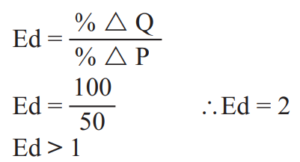
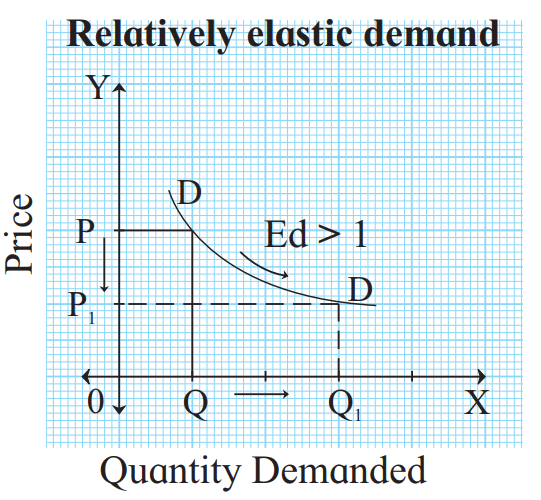
In the above diagram when the price falls from OP to OP1 (50%), demand rises from OQ to OQ1 (100%). Therefore, the demand curve has a flatter slope.
5. Relatively inelastic Demand:
When a change in price brings about less than a proportionate change in quantity demanded of a commodity, it is called as relatively inelastic demand. For example, 50% fall in price leads to 25% rise in quantity demanded.
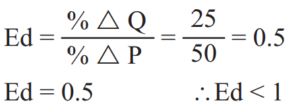
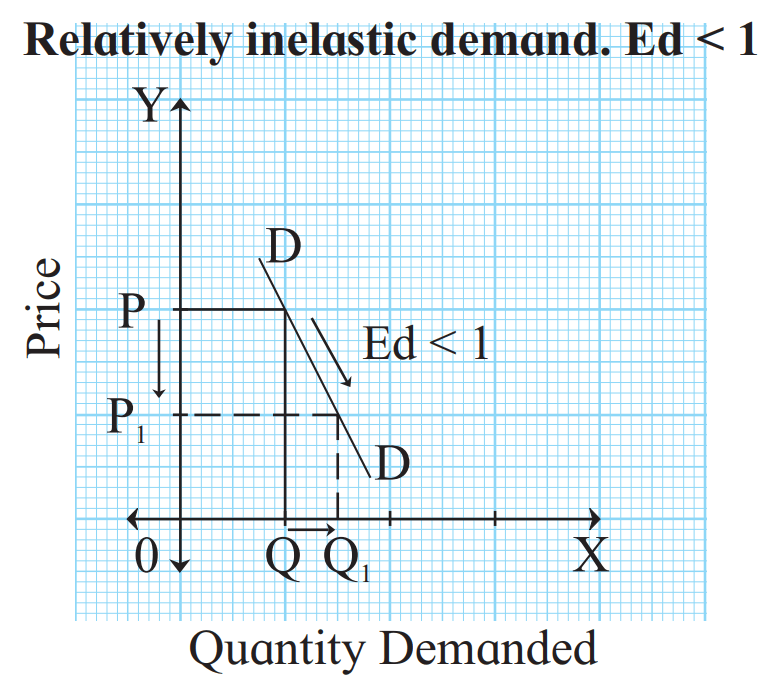
when price falls from OP to OP1 (50%), demand rises from OQ to OQ1 (25%). Therefore, the demand curve has a steeper slope.
Methods of Measuring Price Elasticity of Demand:
1) Ratio or Percentage method:
- The ratio method was developed by Prof. Marshall.
- According to this method, elasticity of demand is measured by dividing the percentage change in demand by the percentage change in price.
- The percentage method is also known as the Arithmetic method.
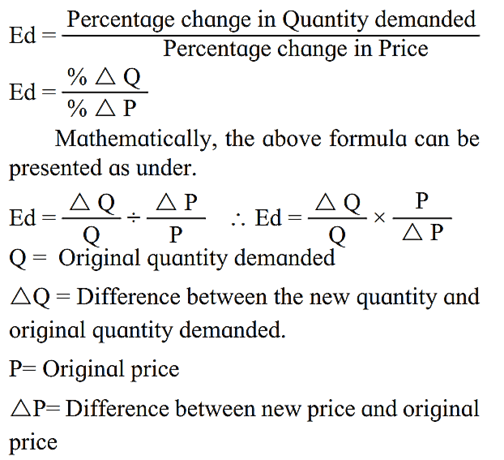

2) Total Expenditure Method :
- The Total Expenditure Method was developed by Prof. Marshall.
- In this method, the total amount of expenditure is compared before and after the price change.
- Total expenditure refers to the product price and quantity demanded.
- Total expenditure = Price × Quantity demanded
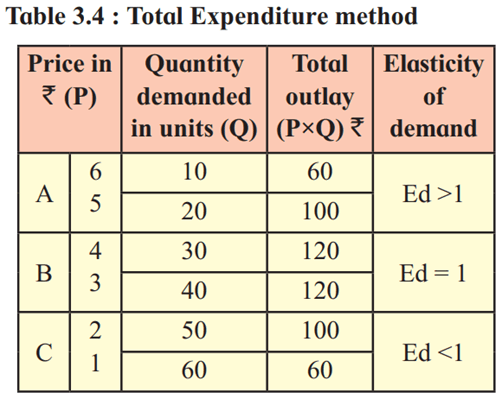
- Relatively elastic demand (Ed >1): When with a given change in the price of a commodity total outlay increases, the elasticity of demand is greater than one.
- Unitary elastic demand (Ed = 1): When the price falls or rises, total outlay does not change or remains constant, the elasticity of demand is equal to one.
- Relatively inelastic demand (Ed <1): When with a given change in price of a commodity total outlay decreases, the elasticity of demand is less than one.
3) Point method or Geometric Method :
- The point method or geometric method was developed by Prof. Marshall
- According to this method, we can measure the elasticity of demand At any point on the demand curve.
- The ratio method and total outlay methods are unable to measure the elasticity of demand at a given point on the demand curve. So Prof. Marshall introduced the Point method or geometric method.

A) Linear Demand Curve :
When the demand curve is linear i.e. a straight line, we extend the demand curve to meet the Y axis at ‘A’ and X axis at ‘B’. Price elasticity of demand at ‘X’ axis is zero and ‘Y’ axis is infinite. The elasticity of demand will be different at each point.
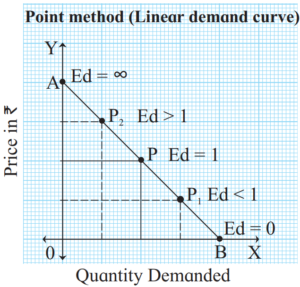
Let us assume that AB is a demand curve and its length is 8 cm. Point elasticity at various points on a linear demand curve can be measured as follows :
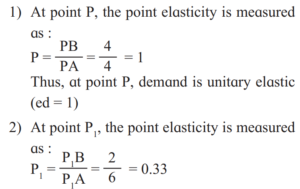
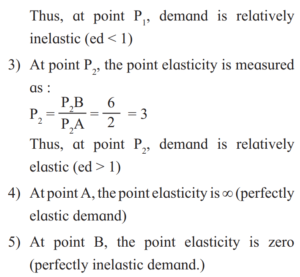
B) Non-linear demand curve :
When the demand curve is non-linear i.e. convex to origin, to measure price elasticity of demand we have to draw a tangent ‘AB’ touching the given point on the demand curve and extending it to meet ‘Y’ axis at point ‘A’ and ‘X’ axis at point ‘B’.
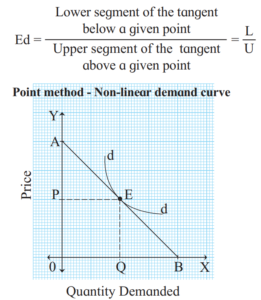
If EB = EA (Ed = 1) – Unitary elastic demand
EB > EA (Ed >1) – Relatively elastic demand
EB < EA (Ed <1) – Relatively inelastic demand
Economics notes |
CLICK HERE |
O.C.M notes |
CLICK HERE |
S.P notes |
CLICK HERE |
Accounts notes |
Click Here |
English notes |
Click Here |
Hindi notes |
Click Here |
Reference: MHSB Books
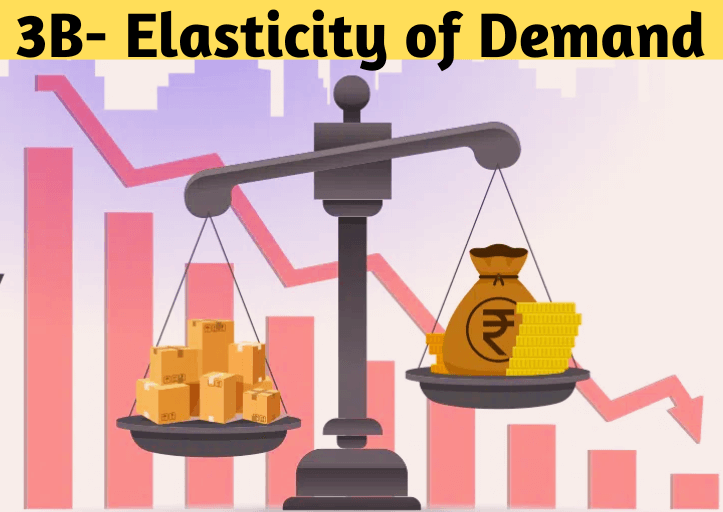


Good
Thank You
Sir please try to more videos upload of economic on YouTube before ending of ower Board Exam (2023-24 HSC board) 🙏
thank you for your suggestion